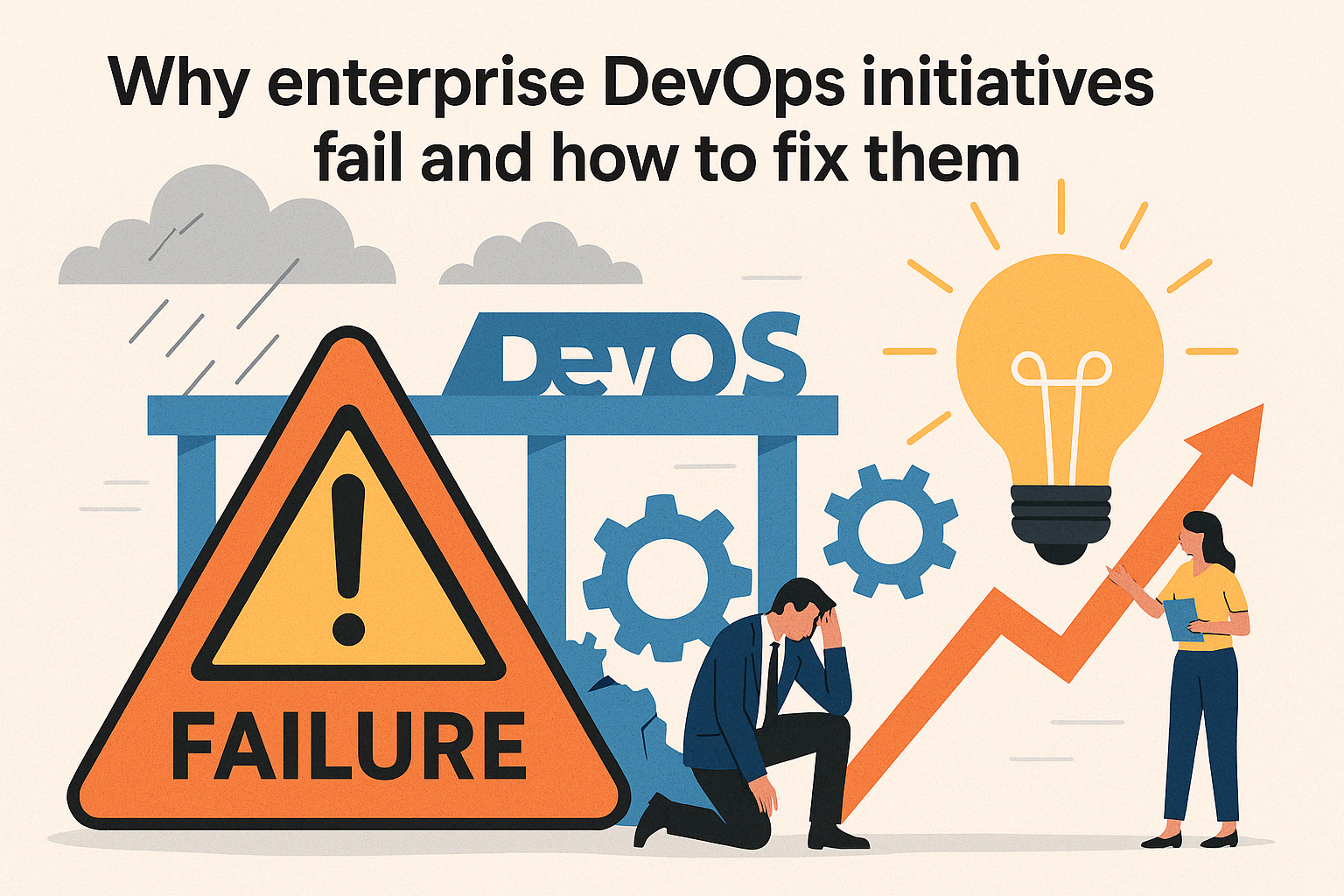
Getting DevOps right in large companies is tricky. It’s been around for nearly two decades, from developers wanting deployment control. It gained traction around 2011-2015, boosted by Gartner, SAFe, and AWS’s rise, pushing CIOs to learn from agile startups.
Despite this history, many DevOps initiatives stumble. Why? Often, the approach misses fundamental truths about making DevOps work in complex enterprises with multi-cloud setups, legacy systems, and pressure for faster results. Let’s explore common pitfalls and how to get back on track.
Thinking DevOps is just another IT project
This is crucial. DevOps isn’t just new tools or org charts; it’s a cultural shift. It’s about Dev, Ops, Sec, and the business working together smoothly, focused on customer value, agility, and stability.
Treating it like a typical project is like fixing a building’s crumbling foundation by painting the walls, you ignore the deep, structural changes needed. CIOs might focus narrowly on IT implementation, missing the vital cultural shift. Overlooking connections to customer value, security, scaling, and governance is easy but detrimental. Siloing DevOps leads to slower cycles and business disconnects.
How to Fix It: Ensure shared understanding of DevOps/Agile principles. Run workshops for Dev and Ops to map the value stream and find bottlenecks. Forge a shared vision balancing innovation speed and operational stability, the core DevOps tension.
Rushing continuous delivery without solid operations
The allure of CI/CD is strong, but pushing continuous deployment everywhere without robust operations is like building a race car without good brakes or steering, you might crash.
Not every app needs constant updates, nor do users always want them. Does the business grasp the cost of rigorous automated testing required for safe, frequent deployments? Do teams have the operational muscle: solid security, deep observability, mature AIOps, reliable rollbacks? Too often, we see teams compromise quality for speed.
The massive CrowdStrike outage is a stark reminder: pushing changes fast without sufficient safeguards is risky. To keep evolving… without breaking things, we need to test everything. Remember benchmarks: only 18% achieve elite performance (on-demand deploys, <5% failure, <1hr recovery); high performers deploy daily/weekly (<10% failure, <1 day recovery).
How to Fix It: Use a risk-based approach per application. For frequent deployments, demand rigorous testing, deep observability (using SRE principles like SLOs), canary releases, and clear Error Budgets.
Neglecting user and developer experiences
Focusing solely on automation pipelines forgets the humans involved: end-users and developers.
Feature flags, for instance, are often just used as on/off switches. They’re versatile tools for safer rollouts, A/B testing, and resilience, missing this potential is a loss.
Another pitfall: overloading developers by shifting too much infrastructure, testing, and security work “left” without proper support. This creates cognitive overload and kills productivity, imposing a “developer tax”, it’s unrealistic to expect developers to master everything.
How to Fix It: Discuss how DevOps practices impact people. Is the user experience good? Is the developer experience smooth, or are engineers drowning? Define clear roles. Consider a Platform Engineering team to provide self-service tools that reduce developer burden.
Letting tool choices run wild without standards
Empowering teams to choose tools is good, but complete freedom leads to chaos, like builders using incompatible materials. It creates technical debt and fragility.
Platform Engineering helps by providing reusable, self-service components (CI/CD, observability, etc.), creating “paved roads” with embedded standards. Most orgs now have platform teams, boosting productivity and quality. Focusing only on tools without solid architecture causes issues. “Automation can show quick wins… but poor architecture leads to operational headaches”.
How to Fix It: Balance team autonomy with clear standards via Platform Engineering or strong architectural guidance. Define tool adoption processes. Foster collaboration between DevOps, platform, architecture, and delivery teams on shared capabilities.
Expecting teams to magically handle risk
Shifting security “left” doesn’t automatically mean risks are managed effectively. Do teams have the time, expertise, and tools for proactive mitigation? Many orgs lack sufficient security support for all teams.
Thinking security is just managing vulnerability lists is reactive. True DevSecOps builds security in. Data security is also often overlooked, with severe consequences. AI code generation adds another layer requiring rigorous testing.
How to Fix It: Don’t just assume teams handle risk. Require risk mitigation and tech debt on roadmaps. Implement automated security testing, regular security reviews, and threat modeling. Define release management with risk checkpoints. Leverage SRE practices like production readiness reviews (PRRs).
The CIO staying Hands-Off until there’s a crisis
A fundamental mistake CIOs make is fully delegating DevOps and only getting involved during crises. Because DevOps often feels “in the weeds,” it tends to be pushed down the hierarchy. But DevOps is strategic, it’s about delivering value faster and more reliably.
Given DevOps’ evolution, expect varied interpretations. As a CIO, be proactively involved. Shape the culture, engage regularly (not just during crises), champion investments (platforms, training, SRE), and ensure alignment with business needs and risk tolerance.
How to Fix It: Engage early and consistently. Champion the culture shift. Ask about value delivery, risk management, and developer productivity. Sponsor platform/SRE teams. Ensure business alignment. Your active leadership is crucial.
Avoiding these pitfalls isn’t magic, DevOps is a continuous journey. But understanding these traps and focusing on culture, solid operations, user/developer experience, sensible standards, proactive risk management, and engaged leadership significantly boosts your chances of building a DevOps capability that delivers real business value.





